| Cross Temple | |
|---|---|
| Native name Chinese: 十字寺 | |
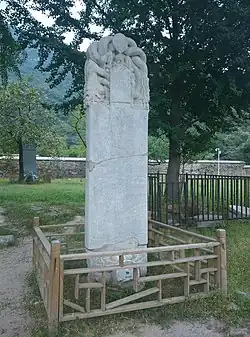 A Yuan-era stele in the ruins of the Cross Temple, featuring a cross carved into its top. Another stele (left) is visible in the background. | |
| Type | Abandoned Buddhist and Nestorian Christian religious site |
| Location | North Sanpen Mountain, Chechang Village, Zhoukoudian, Fangshan District, Beijing |
| Coordinates | 39°44′35″N 115°54′06″E / 39.74306°N 115.90167°E |
| Built | Possibly 317 |
| Rebuilt | 639, c. 960, 1365, 1535 |
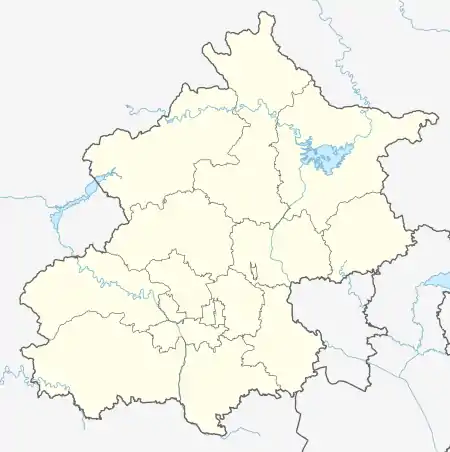 Location of Cross Temple in Beijing 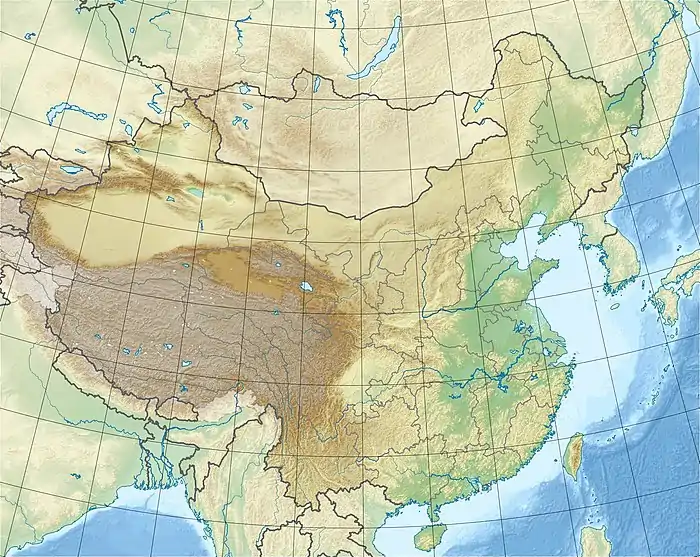 Cross Temple, Fangshan (China) | |
The Cross Temple (Chinese: 十字寺; pinyin: Shízì sì)[lower-alpha 1] is a former place of worship in Fangshan, Beijing. During different periods, it was used by either Buddhists or the Church of the East, a Nestorian Christian sect. It is the only site of the Church of the East in China still in existence.
Scholars debate the periodisation of when the Cross Temple was used by Nestorians. Originally built as Buddhist temple, the site was in use by Nestorians during the Yuan dynasty (1271–1368)—with some hypothesising that it had also been used by Nestorians during the Tang dynasty (618–907). After the end of the Yuan, the temple reverted to Buddhist use until its sale in the early 20th century. The site's buildings were demolished during the late 1950s; presently, only pedestals, steles, and the buildings' foundations remain on-site. In 2006, the ruins were named a Major Historical and Cultural Site Protected at the National Level.
Today, the site features two ancient steles, as well as groundwork and the bases of several pillars. During the early 20th century, two stone blocks featuring carved crosses were discovered at the site; they are now on display at Nanjing Museum.
History
There are two stone steles at the site of the Cross Temple, with one dating to the Liao dynasty (916–1125), and the other to the Yuan dynasty (1271–1368).[4] The inscriptions borne by the steles are the principal sources used to study the site's history, including dates and the names of contemporary people.[5] However, the inscriptions contain errors,[6] and the temple's history remains the subject of considerable speculation among academics.[7]
Early history
According to the Liao stele, a Buddhist monk named Huijin (惠靜) began building the temple in 317—the first year of the reign of Emperor Yuan, founder of the Eastern Jin dynasty (317–420).[8] In 639, during the Tang dynasty (618–907), a monk named Yiduan (義端) re-furnished the temple.[8] The scholar Wang Xiaojing proposes that the author of the Liao stele conflated the Jin with the Later Jin dynasty (936–947).[9] Names for the monastery during Jin and Tang periods is not known.[10]
Nestorian Christianity was first recorded in Tang China during the 7th century,[11] and some scholars suggested that the temple may have belonged to the Church of the East in China around this time. The Japanese scholar P. Y. Saeki speculated that believers fleeing from Chang'an to Youzhou and Liaodong during the 9th-century Huichang persecution of Buddhism, which also affected the Church of the East, began using the temple.[12][13] Tang Xiaofeng additionally points to inscriptions on the Liao stele as an indication that Christian crosses were present at the temple prior to the Liao dynasty. In addition, Tang claims that another text written by Li Zhongxuan in 987 indicated a Nestorian presence in Youzhou.[14] However, British sinologist Arthur Christopher Moule believed that there was insufficient evidence to show that the Church of the East existed in Beijing before the 13th century.[13]
10th century
According to the Liao stele, the Cross Temple used to be called "Chongsheng Yuan" (崇聖院) during the Liao dynasty, when Buddhists rebuilt it during the reign of Emperor Muzong of Liao. However, the exact date of rebuilding was unclear: although the stele claims the tenth year of Emperor Yuan's reign—corresponding to 960—it states "Bingzi" (丙子) as the sexagenary cycle; these two statements do not align,[15] differing by a span of 16 years.[4] The Liao stele does not indicate any relationship between the site and Christianity, and it is believed that Chongsheng Yuan was a Buddhist temple.[16] The scholar Xu Pingfang held that Nestorian activities at the site commenced only after Buddhist activity had ended.[17]
13th–14th centuries
After the Mongol conquest of the Jurchen Jin capital of Zhongdu (located in modern Beijing) in 1215, Nestorianism began spreading throughout the area. During the Yuan, Beijing had a metropolitan bishop.[18] Wang hypothesized that a Nestorian passed by Fangshan, discovered the abandoned temple, and turned it into a monastic retreat.[19] Tang Xiaofeng and Zhang Yingying suggest it is also possible that the Cross Temple was rebuilt during this period.[20]
Many scholars have considered that the Nestorian monk Rabban Sauma, a Uyghur born in Beijing during the Yuan,[21][22] may have some connection to the Cross Temple. Moule conjectures that the site was probably near the retreat of Bar Sauma.[23] Shi Mingpei argues that the description of Rabban Sauma's retreat is "extremely similar" to the Cross Temple and its surrounding terrain.[24] In her 2011 book East Syriac Christianity in Mongol-Yuan China, Tang Li asserts that Rabban Sauma came from the site.[25]
Wang estimates that Nestorians abandoned the site before 1358, when it began to be rebuilt by Buddhist monks;[19] this rebuilding was completed in 1365.[16] According to the Yuan stele, a Buddhist monk named Jingshan (淨善) initiated the reconstruction because he dreamed of a deity in his meditation, and then saw a shining cross on top of an ancient dhvaja at the temple site.[26] The Yuan stele records the temple's major benefactors as being the prince of Huai Temür Bukha, the eunuch-official Zhao Bayan Bukha, and the minister Qingtong, with the inscription itself being made by Huang Jin.[17] In 1992, Xu Pingfang suggested that Temür Bukha would be familiar with Nestorian practices because of his Nestorian grandmother Sorghaghtani Beki. Therefore, he would request that the Buddhist temple continue to use the name "Cross Temple" when it was rebuilt, and that its Nestorian artefacts to be preserved.[17] However, modern scholars generally consider the information regarding the Yuan benefactors to be false, and the inscription itself to be a forgery done during the Ming dynasty.[27][28]
Wang suggests that the official name of the temple during the Yuan period was "Chongsheng Yuan".[19] She further argues that the Han Chinese population at the time used the term "cross temple" to refer to Nestorian churches in general, and that Nestorians at the time would not have called it "Cross Temple".[29] However, because the name "Cross Temple" was simple and direct, local residents began to use it after the arrival of the Nestorians.[30]
15th–16th centuries
Nestorians continued to have a presence in northern China during the early Ming dynasty (1368–1644). During the reign of Emperor Yingzong of Ming (1436–1449), some Nestorians were still present in Fangshan: a record shows that some Nestorian monks visited Fangshan's Yunju Temple around the year 1437.[lower-alpha 2][17][31] The Jesuit missionary Matteo Ricci learned from a Jewish person that there was an existing Nestorian population in northern China. According to Ricci, the Chinese Nestorians were keeping their religious identity a secret, but they still referred to a former Nestorian church as the "Cross Church".[32]
In 1535, the site was rebuilt by a Buddhist monk named Dejing (德景), supported by local villagers and the family of Gao Rong (高榮), a nephew of the powerful eunuch official Gao Feng. During reconstruction, the inscriptions of the Liao and Yuan steles were altered—with the building officially known as the "Cross Temple" by this time.[19]
20th–21st centuries
Around 1911, the Buddhist monks sold the temple and the surrounding lands.[34] According to P. Y. Saeki, the Scottish diplomat Reginald Johnston first rediscovered the site during the summer of 1919.[35] Saeki himself visited the site in 1931, and recorded that most of the site's buildings still existed at that time.[36] According to Saeki, the first building after the Shanmen entry was the Hall of Four Heavenly Kings. Beyond the hall, there was a courtyard with two gingko trees, and the Liao and Yuan steles were next to each tree. To the right of the courtyard, there was a kitchen and a dormitory for the monks. To the left of the courtyard, there was another dormitory building. The Main Hall of the temple was at the end of the courtyard, and it contained three statues of Buddha.[37]
.jpg.webp)
In the 1950s, following the establishment of the People's Republic of China, the remaining buildings of the Cross Temple were destroyed.[38] During the Cultural Revolution, the two steles were knocked down and broken into pieces.[39] In the 1990s, the Beijing branches of the China Christian Council (CCC) and the Three-Self Patriotic Movement (TSPM) rebuilt the walls around the Cross Temple site.[40] In 2006, its ruins were named a Major Historical and Cultural Site Protected at the National Level.[41]
Current state
The Cross Temple is the only surviving Nestorian site in China.[42] It is located near Chechang Village (车厂村), Fangshan. The grounds are 50 m (160 ft) across from east to west, and 45 m (148 ft) across from north to south. It is surrounded by walls on four sides, with entrances in the north and south. No buildings remain standing.[43]
There is some groundwork at the north and west parts of the site, where the Main Hall and the dormitory of the Buddhist monks once stood.[6] The Main Hall measured 11.32 m (37.1 ft) from north to south, and 19.6 m (64 ft) from east to west. There are pillar bases scattered the ruins of the Main Hall, and remnants of stairs in front.[43]
In front of the Main Hall, there are two gingko trees: one ancient, and one new. The newer tree was planted to replace another ancient one, which was destroyed by fire.[40] There was a Shanmen building 17.5 m (57 ft) to the south of the Main Hall, with dimensions 7.08 m (23.2 ft) by 11.24 m (36.9 ft), but its ruins are hardly noticeable now.[44]
Relics
Stone steles
.jpg.webp)
There are two steles at the Cross Temple site: the Liao stele was raised in 960, and the Yuan stele was raised in 1365. Both were re-carved during the Ming dynasty in 1535. During the Cultural Revolution, the steles Liao stele was broken in the middle and part of its bottom left corner went missing, while the Yuan stele was broken into three pieces. During the early 21st century, both were repaired and re-raised.[39] Both steles bear inscriptions, though they do not explicitly mention Christianity.[27] The Yuan stele features a cross at its top, but it is not likely made by the Nestorians, as stele making was a Han Chinese practice, but there were very few Han Nestorians during the Yuan dynasty.[45]
Scholars generally agree that while the two steles were from the Liao and Yuan dynasties respectively, their inscriptions were tampered with by Ming writers, and there are errors in their stated dates and names of individuals.[46][47] According to Wang Xiaojing, in order to elevate the temple's status and garner more support and donations from Buddhists,[48] the Ming writers changed the inscriptions of the two steles to claim that the temple received royal charters,[49] that it had received donations from famous figures, and that it had been larger in size during the Yuan period. Tang Xiaofeng and Zhang Yingying suggest that the altered inscriptions were based on existing rumours.[47]
A replica of the Xi'an Stele was added to the site during the early 21st century, placed in front of the north wall.[44]
Stone plaque
A stone plaque inscribed with the characters 『古刹十字禅林』 ('Ancient Cross Buddhist Temple') had previously been installed atop the temple's gate.[50] Records from 1919 indicated the plaque was still present, but in 1931 Saeki noted that it had fallen off and broken. When Wu Mengling (吴梦麟) visited the site in October 1992, he found one of the broken pieces in front of the gingko trees.[51] According to Wang, the plaque is currently stored by the Fangshan District Bureau of Cultural Artifacts,[51] though Tang and Zhang claim it is on display at the Beijing Stone Carving Art Museum.[52]
Carved stone blocks
There were previously two blocks of carved stone at the Cross Temple site. They are first mentioned by H. I. Harding, second secretary of the English mission in Peking,[2] who wrote that they were discovered in the summer of 1919 by Christopher Irving—a pseudonym of Reginald Johnston.[53] Harding recorded claims by the monks that the blocks had been discovered underground in 1357, during repairs to the temple's Hall of Heavenly Kings.[54]
Fearing that foreigners might remove the stone blocks from the site, Zhuang Shangyan and Wang Zuobin of the Peiping Commission for the Preservation of Antiquities (北平古物保管委員會) surveyed the site in September 1931.[55] The following month, the blocks were transported to the Peiping Museum of History[lower-alpha 3] for exhibition.[55][40] During the Second Sino-Japanese War, they were transferred to Nanjing, and are currently on display in the Nanjing Museum. A replica of one of the blocks is in the collection of the National Museum of China, and two replicas are at the nearby Yunju Temple.[40]
Description
The two stone blocks are rectangular, with a vertical hollow in the rear. They are 68.5 cm (27.0 in) tall and 58.5 cm (23.0 in) wide. For each, the front face and sides are 22 cm (8.7 in) and 14 cm (5.5 in) thick, respectively. Each have crosses carved into their front face, and flowers carved into each of their two sides.[55] According to Tang Li, Christians following East Syrian traditions in the Far East often showed an adoration of the cross and images.[56]
While both feature crosses and flowers in vases, details of the carvings differ between the two blocks. The sides of one block feature chrysanthemums in a vase;[55] the cross on its front is supported by clouds and lotuses, and features a Baoxianghua pattern (寶相花紋) at its centre. Additionally, the cross is surrounded by an inscription in Syriac, which reads:[55][23]
ܚܘܪܘ ܠܘܬܗ ܘ ܣܒܪܘ ܒܗ[lower-alpha 4]
Look ye unto it and hope in it.
According to Moule, F. C. Burkitt found the same text, with the addition of the phrase "the living cross", in one of the Syriac manuscripts in the British Museum.[23] P. G. Borbone stated that a bronze mirror discovered in Inner Mongolia was possibly produced "in imitation" of the Fangshan cross.[59]

On the other stone block, the cross also has a Baoxianghua pattern, but there are two heart-like shapes extensions at the left and right ends of the cross. It is also mounted on two layers of lotuses, one facing up and one facing down. On the side, it depicts peonies in a basin.[60]
Xu Pingfang noted that the style of the details of the carvings is similar to other Yuan Erkehün[lower-alpha 6] carved stones, and flowers were a contemporary theme. He considered the two stone blocks "the most exquisite" among the cross carvings from the Yuan dynasty currently known.[61]
See also
Nestorians in China
- Alopen – 7th-century Nestorian missionary, first recorded Nestorian Christian to have reached China
- Adam – 8th-century Nestorian monk in China
- Rabban Bar Sauma – 13th-century Yuan Nestorian monk who travelled from China to the Middle East and Europe
- Yahballaha III – 13th-century Yuan Nestorian monk, pupil of Bar Sauma, later Patriarch of the Church of the East
Nestorian artefacts
- Murals from the Christian temple at Qocho – Christian murals dating to the 7th—9th centuries
- Xi'an Stele – 8th-century Tang-era stele documenting Nestorian Christianity in China
- Nestorian pillar of Luoyang – 9th-century Tang Chinese pillar
- Daqin Pagoda – claimed to be a Tang-era Nestorian site
Christianity in Beijing
- List of Major National Historical and Cultural Sites in Beijing
- Cathedral of the Immaculate Conception, Beijing – the oldest Catholic church in Beijing
- Zhalan Cemetery – a Ming-era cemetery in Beijing for Catholic missionaries who died in China
- Holy Saviour's Cathedral – a former Anglican cathedral
- Christian-founded institutions: Peking Union Medical College (est. 1906), Yenching University (1919–1952), Fu Jen Catholic University (est. 1925, later re-established in Taiwan in 1961)
Other West Asian religious sites in China
- Xianshenlou – the sole surviving Zoroastrian building in China, built during the Song dynasty (960–1279)
- Cao'an – a Song dynasty temple originally used by Chinese Manichaeists, now used by Buddhists
- Huaisheng Mosque in Guangzhou, built during the 7th century
Notes
- ↑ In English literature, the site is also known as the Temple of the Cross[1][2] or the Monastery of the Cross.[3]
- ↑ According to Xu's transcription of the record in his 1992 paper, it was the third year of Zhengtong era (1438).[17] However, Shi put the second year of Zhengtong (1437) in his 2000 paper.[31]
- ↑ 北平歷史博物館, the precursor of the National Museum of China in Beijing.
- ↑ Romanization: ḥwrw lwth wsbrw bh. Pronunciation: ḥur lwātēh w-sabbar bēh.[57]
- ↑ F. C. Burkitt identified, transcribed, and translated this inscription.[23]
- ↑ During the Yuan dynasty, Nestorians were called "Erkehün" (也里可溫).[29]
References
Citations
- ↑ Borbone 2006, p. 7.
- 1 2 Marsone 2013, p. 205.
- ↑ Nicolini-Zani 2011, p. 356.
- 1 2 Tang 2011a, p. 120.
- ↑ Wang 2018, pp. 309–310.
- 1 2 Wang 2018, p. 310.
- ↑ Tang 2011a, pp. 118, 122–124.
- 1 2 Wang 2018, p. 317.
- ↑ Wang 2018, p. 342.
- ↑ Tang & Zhang 2018, p. 88.
- ↑ Shi 2000, p. 90.
- ↑ Saeki 1943, p. 507.
- 1 2 Tang 2011a, p. 123.
- ↑ Tang 2011a, pp. 123–124.
- ↑ Wang 2018, p. 317–319.
- 1 2 Xu 1992, p. 187.
- 1 2 3 4 5 Xu 1992, p. 188.
- ↑ Shi 2000, p. 91, 「1215年蒙古军攻下金中都(北京)后,景教即传入北京。北京作为景教的一个大主教区,派驻有大主教」
- 1 2 3 4 Wang 2018, p. 343.
- ↑ Tang & Zhang 2018, pp. 91–92.
- ↑ Tang 2011b, p. 108.
- ↑ Shi 2000, p. 91, 「据史籍记载,当时有一位出生在北京的景教修士拉班·扫马」
- 1 2 3 4 Moule 2011, p. 88.
- ↑ Shi 2000, p. 92, 「值得注意的是,据记载,拉班·扫马的静修处,距城有一天的路程,在附近的山上有一个山洞,紧靠洞旁有一清泉。其地形地貌与房山十字寺及附近的三盆山极其相似」, referencing Zhu, Qianzhi (1993). 《中国景教》 [Nestorianism in China]. People's Publishing House. ISBN 9787010026268.
- ↑ Tang 2011b, p. 108, "The Rabban Sauma mentioned in the History of Yaballaha III came from this monastery in Fangshan".
- ↑ Wang 2018, p. 318.
- 1 2 Tang & Zhang 2018, p. 86.
- ↑ Wang 2018, p. 328.
- 1 2 Wang 2018, p. 340.
- ↑ Wang 2018, p. 341.
- 1 2 Shi 2000, p. 91.
- ↑ Shi 2000, p. 93.
- ↑ Bar Sauma & Markos 1928, Appendix B to the Introduction: The Nestorian Stele at Hsi-An-Fu.
- ↑ Xu 1992, p. 185, citing 《房山縣十字石刻詳紀》; "A Record of the Cross-carved Stones in Fangshan". Ta Kung Pao, literary supplement no. 195. 1931-10-05.
- ↑ Zhou 2017, p. 47, citing Saeki, P. Y. 1951. The Nestorian Documents and relics in China. The Maruzen Company Ltd., Tokyo..
- ↑ Tang 2011a, p. 118.
- ↑ Tang 2011a, p. 119, citing Saeki 1943, pp. 500–502.
- ↑ Cao 2000, p. 42-43.
- 1 2 Wang 2018, pp. 311–312.
- 1 2 3 4 Tang 2011a, p. 119.
- ↑ Wang 2018, p. 314.
- ↑ Shi 2000, pp. 90–91.
- 1 2 Wang 2018, pp. 310–311.
- 1 2 Wang 2018, p. 311.
- ↑ Wang 2018, pp. 339, 341.
- ↑ Wang 2018, p. 320.
- 1 2 Tang & Zhang 2018, pp. 87–88.
- ↑ Wang 2018, p. 338, 「这一切其实都是为了让“敕赐碑”显得真实,从而提高该寺的规格,并得到信众的支持资助。拨开笼罩在元碑上的敕赐迷雾,元碑记述的寺庙情况应该是基本可信的」
- ↑ Wang 2018, pp. 326–327, ⌈笔者认为,“敕赐”二字是明代改刻重刻碑文的关键所在。“敕赐”即皇帝钦赐的意思。由于该寺未得到当朝皇帝“敕赐”,原碑文中亦未见“敕赐”二字,因此才要编造“敕赐”碑的谎话」
- ↑ Tang & Zhang 2018, p. 83.
- 1 2 Wang 2018, p. 312.
- ↑ Tang & Zhang 2018, p. 82.
- ↑ Zhou 2017, p. 47, citing Saeki, P. Y. 1951. The Nestorian Documents and relics in China. The Maruzen Company Ltd., Tokyo.
- ↑ Moule 2011, p. 86.
- 1 2 3 4 5 Xu 1992, p. 184.
- ↑ Tang 2011b, p. 140, "Adoration of the cross and images was another characteristic of the East Syrian traditions in the Far East".
- ↑ Borbone 2019, pp. 137–138.
- ↑ Borbone 2006, p. 2.
- ↑ Borbone 2019, p. 146.
- ↑ Xu 1992, pp. 184–185.
- ↑ Xu 1992, p. 185, 「為目前所見元代也里可溫十字架石刻中最精美的兩塊」
Dissertations
- Zhou, Yixing (2017). Studies on Nestorian Iconology in China and part of Central Asia during the 13th and 14th Centuries (PDF) (PhD thesis). Ca' Foscari University of Venice.
Journal articles
- Borbone, Pier Giorgio (2019). "A "Nestorian" Mirror from Inner Mongolia". Egitto e Vicino Oriente. Pisa University Press. 2019 (XLII): 135–149. doi:10.12871/978883339342112. S2CID 234692204.
- Cao, Xinhua (2000). 房山十字寺的变迁 [History of the Cross Temple at Fangshan]. 中国宗教 [Religions in China]. 2000 (3): 42–43. ISSN 1006-7558.
- Nicolini-Zani, Matteo (2011). "Reviewed Work(s): East Syriac Christianity in Mongol-Yuan China. Orientalia Biblica et Christiana, vol. 18 by Li Tang". China Review International. University of Hawai'i Press. 18 (3): 354–358. doi:10.1353/cri.2011.0078. JSTOR 23733468. S2CID 142980336.
- Qian, Yuchen (2021). "Another Evangelism: Missionary Visuality as Transcultural Conversations in China and Japan, from Pre-modern to Modern Periods" (PDF). Waseda RILAS Journal (9): 247–63.
- Qiu, Shusen (2002). 元亡后基督教在中国湮灭的原因 [The Reason of the Annihilation of Christianity after the Overthrown of the Yuan Dynasty in China]. 世界宗教研究 [Studies in World Religions] (in Chinese). 2002 (4): 56–64, 156.
- Shi, Mingpei (March 2000). 略论景教在中国的活动与北京的景教遗迹 [Jing-jiao (Nestorianism) in China and Its Remains in Beijing]. 北京联合大学学报 北京联合大学学报 [Journal of Beijing Union University] (in Chinese). 14 (1): 90–93. doi:10.16255/j.cnki.ldxbz.2000.01.025.
- Tang, Xiaofeng (2011a). 北京房山十字寺的研究及存疑 [Studies and Questions on the Cross Temple, Fangshan, Beijing]. 世界宗教研究 [Studies in World Religions] (in Chinese). 2011 (6): 118–25.
- Wang, Xiaojing (2018). 房山十字寺辽、元二碑与景教关系考 [A Study on the Relationship between the Two Steles from Liao and Yuan Dynasties at the Cross Temple, Beijing, and the Church of the East in China]. 北京史学 [Beijing History] (in Chinese). 2018 (2): 309–43.
- Xu, Pinfang (1992). 北京房山十字寺也里可温石刻 [Yelikewen Stone Carvings at the Cross Temple, Fangshan, Beijing]. 中国文化 [Chinese Culture] (in Chinese). 1992 (7): 184–89.
Book chapters
- Borbone, Pier Giorgio (2006). "Peshitta Ps 34:6 from Syria to China". In W.Th. van Peursen; R.B. ter Haar Romeny (eds.). Text, Translation, and Tradition: Studies on the Peshitta and its Use in the Syriac Tradition. Brill. ISBN 978-90-47-41057-7.
- Marsone, Pierre (2013). "When was the Temple of the Cross at Fangshan a "Christian Temple"?". In Tang, Li; Winkler, Dietmar W. (eds.). From the Oxus River to the Chinese Shores: Studies on East Syriac Christianity in China and Central Asia. LIT Verlag Münster. ISBN 978-3-643-90329-7.
- Tang, Xiaofeng; Zhang, Yingying (2018). "Fangshan Cross Temple (房山十字寺) in China: Overview, Analysis and Hypotheses". In Huang, Paulos Z. (ed.). Yearbook of Chinese Theology. Vol. 4. pp. 82–94. doi:10.1163/9789004384972_007. ISBN 978-90-04-38497-2.
Books
- Bar Sauma; Markos (1928) [Written during the Yuan dynasty, manuscript found in 1887]. The Monks of Kûblâi Khân, Emperor of China. Translated by E.A. Wallis Budge. London: Religious Tract Society.
- Moule, A. C. (2011) [1930]. Christians in China Before the Year 1550. Beijing: Gorgias Press. ISBN 978-1-61143-605-1.——— (1984). Xie, Fang (ed.). 一五五〇年前的中国基督教史 [Christians in China Before the Year 1550] (in Chinese). Translated by Hao, Zhenhua. Beijing: Zhonghua Book Company. (Chinese translation)
- Saeki, Yoshiro (1943). 支那基督敎の硏究〈1〉唐宋時代の支那基督教 [Research on Chinese Christianity, Book I: Chinese Christianity during the Tang and Song dynasties]. 春秋社.
- Tang, Li (2011b). East Syriac Christianity in Mongol-Yuan China (12th–14th centuries) (1st ed.). Harrassowitz Verlag. doi:10.2307/j.ctvc16hhv.
Further reading
- Tang, Li; Winkler, Dietmar W., eds. (2013). From the Oxus River to the Chinese Shores: Studies on East Syriac Christianity in China and Central Asia. LIT Verlag Münster. ISBN 978-3-643-90329-7.
- Wu, Mengling; Xiong, Ying (2010). 北京地区基督教史迹研究 [Studies on Christian Historical Sites in Beijing] (in Chinese). 文物出版社.
- Zhu, Qianzhi (1993). 中国景教 [Nestorianism in China] (in Chinese). People's Publishing House. ISBN 9787010026268.
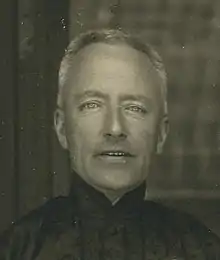
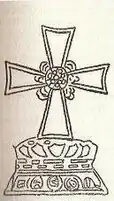
.jpg.webp)

